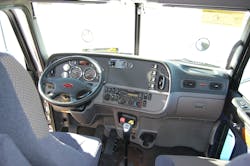Automated manual transmissions (AMTs) and their fully-automatic brethren are projected to gain significant ground in the North American truck market over the next decade, according to new research conducted by global consulting firm Frost & Sullivan.
The firm predicts that AMTs and automatics will experience a compound annual growth rate (CAGR) of 3.9% and 2.9%, respectively, through 2025, while manual transmission demand will shrink by 2.7% over the same time period.
By 2025, Frost & Sullivan expects the market share for manual transmissions among North American medium- and heavy-duty trucks will decline to 43.5%, while AMT market share will climb to 29.4%, with automatics at 27.1%.
“The market is on fire,” Sandeep Kar, global VP of the firm’s automotive & transportation research practice, told Fleet Owner. “AMTs used to have less than 5% to 6% market share and they are now in the double digits. Economies of scale are shrinking the price difference [with manuals] and the benefit of higher efficiency is attracting more fleets.”
Silpa Paul, the researcher in charge of the study, explained to Fleet Owner that fuel savings and driver recruitment/retention benefits are the two factors driving higher adoption of AMTs and automatics among trucking companies – with more demand for AMTs at the moment.
“Fuel costs can account for 50% to 65% of a fleet’s operating costs, making it the highest cost component for fleets,” she said. “Studies show that adoption of AMTs and ATs can improve truck fuel efficiency in varying degrees depending on truck operating duty cycle [with] AMTs especially beneficial in drive cycles with high idling time in comparison to MTs [manuals transmissions and conventional ATs [automatic transmissions].”
Paul added that as truck drivers from the baby-boomer generation retire and are replaced by millennials, training and retention costs are escalating because younger drivers lack basic familiarity with manuals, especially in North America, where passenger cars are now largely equipped with automatics.
Fleets are also looking to leverage telematics to gain more benefits as well, she pointed out.
“Manual transmissions are not ‘smart’ devices,” Paul said, noting that as AMTs and automatics are electronically controlled transmissions (ECTs), they can now be “integrated” with telematics to gain more performance data from the truck.
“This is a great value-add for fleets,” Paul emphasized.
Other data revealed by Frost & Sullivan’s global truck transmission study includes:
- The medium-duty truck premium for AMTs averages $600-$3,000, increasing to $1,000-$5,000 for heavy-duty units.
- The medium-duty truck premium for fully-automatic transmissions averages $3,000-$6,000, rising to $6,000-$10,000 for heavy-duty units.
- Where newer dual clutch automated transmissions (DCTs) are concerned, the medium-duty premium averages $3,000-$5,000, while the heavy-duty premium averages $5,000-$10,000.
- Those high incremental costs versus the potential fuel savings is the primary factor presently inhibiting mass adoption of ECTs as a group, the firm noted.
- Globally, AMTs are expected to experience the highest rate of adoption over the next decade with a CAGR of 12.5%, while ATs will experience a CAGR of 7.7%.
- Downspeeding, engine downsizing, and the increasingly “vertical integration” of truck transmissions in North America, Europe, and Asia is “catalyzing” the adoption of ECTs. Truck OEMs in particular are using ECTs to meet the higher torque requirements downspeeding places on powertrains.
- European truck manufacturers already offer AMTs as “standard fitment” in both medium- and heavy-duty trucks; their market share topped 55.4% among European Union trucks last year.
- However, the manual transmission will still dominate in trucks with gross vehicle weight ratings (GVWRs) exceeding 16 tons, Frost & Sullivan stressed as the fuel economy benefits of ECTs aren’t as yet conclusively proven.
- That being said, manual transmissions will still experience a decline in global heavy-duty truck market share from 81.4% currently to 65.5% by 2025.
About the Author
Sean Kilcarr
Editor in Chief
Sean Kilcarr is a former longtime FleetOwner senior editor who wrote for the publication from 2000 to 2018. He served as editor-in-chief from 2017 to 2018.
